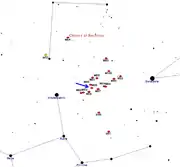| Messier 89[1] | |
|---|---|
 M89 by Hubble Space Telescope. | |
| Observation data (J2000 epoch) | |
| Constellation | Virgo |
| Right ascension | 12h 35m 39.8s[2] |
| Declination | +12° 33′ 23″[2] |
| Redshift | 0.001134±0.000014[2] |
| Heliocentric radial velocity | 340±4 km/s[2] |
| Galactocentric velocity | 290±5 km/s[2] |
| Distance | 50 ± 3 Mly (15.33 ± 0.92 Mpc) |
| Apparent magnitude (V) | 9.8[3] |
| Characteristics | |
| Type | E,[2] LINER,[2] HIISy2[2] |
| Apparent size (V) | 5.1 × 4.7 moa[2] |
| Other designations | |
| NGC 4552,[2] UGC 7760,[2] PGC 41968[2] | |
References: SIMBAD: Search M89 | |
Messier 89 (M89 for short, also known as NGC 4552) is an elliptical galaxy in the constellation Virgo. It was discovered by Charles Messier on March 18, 1781. M89 is a member of the Virgo Cluster of galaxies.[3]
Features
Current observations allow the possibility that M89 may be nearly perfectly spherical. Distinct flattening as ellipsoids is found in all easily measurable comparators up to a few times of its distance. The alternative explanation is that it is an ellipsoid oriented so that it appears spherical to an observer on Earth.
The galaxy features a surrounding structure of gas and dust, extending up to 150,000 light-years and jets of heated particles up to two-thirds of that.[4] This indicates that it may have once been an active quasar or radio galaxy.[4] M89 has an extensive and complex system of surrounding shells and plumes, indicating that it has seen one or several notable mergers.[5]
Chandra studies in the wavelength of the X-Rays show two ring-like structures of hot gas in M89's nucleus, suggesting an outburst there 1 to 2 million years ago[6] as well as ram-pressure stripping acting on the galaxy as it moves through Virgo's intracluster medium.[7] The supermassive black hole at the core has a mass of (4.8±0.8)×108 M☉.[8]
M89 also has a large array of globular clusters. A 2006 survey estimates that there are 2,000 ± 700 of these within 25′. This compares to 150 to 200 of these thought (among which many proven) to surround the Milky Way.[9]
Gallery
.jpg.webp) Messier 89 by the Sloan Digital Sky Survey
Messier 89 by the Sloan Digital Sky Survey Map of M89
Map of M89 HST image of M89
HST image of M89
See also
References
- ↑ J. L. Tonry; A. Dressler; J. P. Blakeslee; E. A. Ajhar; et al. (2001). "The SBF Survey of Galaxy Distances. IV. SBF Magnitudes, Colors, and Distances". Astrophysical Journal. 546 (2): 681–693. arXiv:astro-ph/0011223. Bibcode:2001ApJ...546..681T. doi:10.1086/318301. S2CID 17628238.
- 1 2 3 4 5 6 7 8 9 10 11 12 "NASA/IPAC Extragalactic Database". Results for NGC 4552. Retrieved 2006-10-24.
- 1 2 "Elliptical Galaxy M89 @ SEDS Messier pages".
- 1 2 Messier Objects 81-90 @ Sea and Sky
- ↑ Janowiecki, Steven; Mihos, J. Christopher; Harding, Paul; Feldmeier, John J.; et al. (2010). "Diffuse Tidal Structures in the Halos of Virgo Ellipticals". The Astrophysical Journal. 715 (2): 972–985. arXiv:1004.1473. Bibcode:2010ApJ...715..972J. doi:10.1088/0004-637X/715/2/972. S2CID 119196248.
- ↑ Machacek, M.; Nulsen, P. E. J.; Jones, C.; Forman, W. R. (2014). "Chandra Observations of Nuclear Outflows in the Elliptical Galaxy NGC 4552 in the Virgo Cluster". The Astrophysical Journal. 648 (2): 947–955. arXiv:astro-ph/0604406. Bibcode:2006ApJ...648..947M. doi:10.1086/505963. S2CID 14060525.
- ↑ Machacek, M.; Jones, C.; Forman, W. R.; Nulsen, P. (2006). "Chandra Observations of Gas Stripping in the Elliptical Galaxy NGC 4552 in the Virgo Cluster". The Astrophysical Journal. 644 (1): 155–166. arXiv:astro-ph/0508588. Bibcode:2006ApJ...644..155M. doi:10.1086/503350. S2CID 17223014.
- ↑ Graham, Alister W. (November 2008), "Populating the Galaxy Velocity Dispersion - Supermassive Black Hole Mass Diagram: A Catalogue of (Mbh, σ) Values", Publications of the Astronomical Society of Australia, 25 (4): 167–175, arXiv:0807.2549, Bibcode:2008PASA...25..167G, doi:10.1071/AS08013, S2CID 89905.
- ↑ Tamura, Naoyuki; Sharples, Ray M.; Arimoto, Nobuo; Onodera, Masato; et al. (2006). "A Subaru/Suprime-Cam wide-field survey of globular cluster populations around M87 - I. Observation, data analysis and luminosity function". Monthly Notices of the Royal Astronomical Society. 373 (2): 588–600. arXiv:astro-ph/0609067. Bibcode:2006MNRAS.373..588T. doi:10.1111/j.1365-2966.2006.11067.x. S2CID 15127905.
External links
 Media related to Messier 89 at Wikimedia Commons
Media related to Messier 89 at Wikimedia Commons- SEDS: Messier Object 89
- Messier 89 on WikiSky: DSS2, SDSS, GALEX, IRAS, Hydrogen α, X-Ray, Astrophoto, Sky Map, Articles and images
